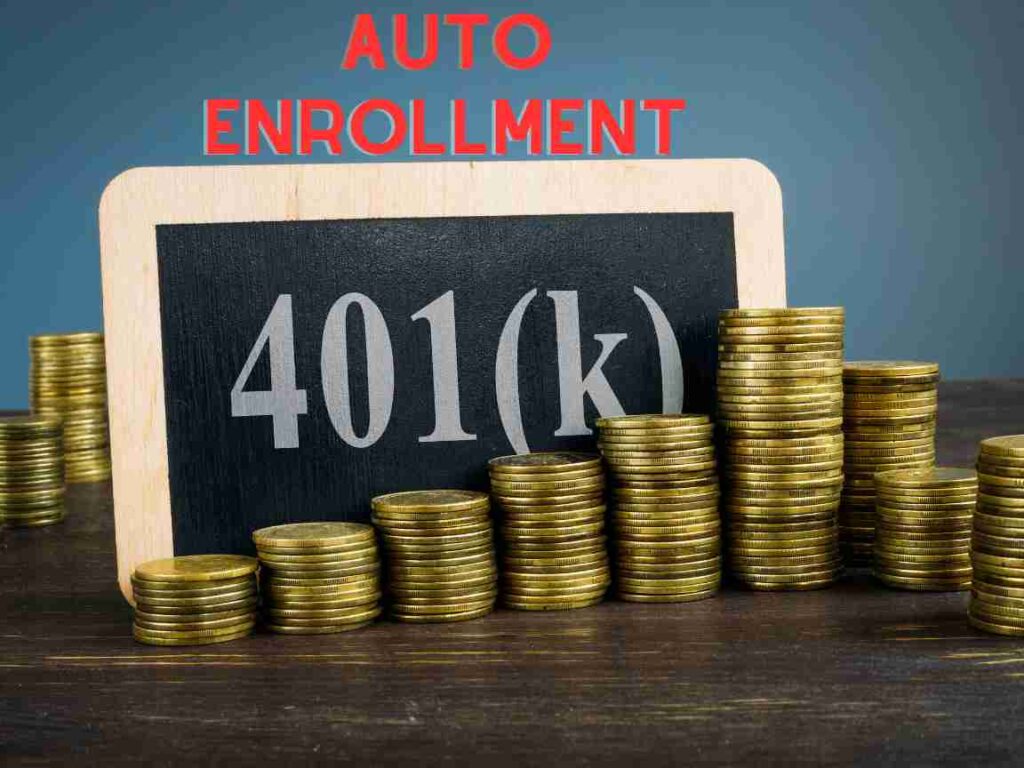Welcome, dear readers! As we traverse the complex and ever-changing landscape of personal finance, we often stumble upon innovative ways to secure our futures. One such path that leads us towards a financially secure retirement is the concept of Auto enrollment 401k. This is where the journey starts, where every paycheck becomes a stepping stone towards the golden years of retirement.
Auto enrollment rules are the guiding principles for this system, ensuring a smooth process for both the employer and the employee. Here, we delve into the intricacies of 401(k) auto enrollment, helping you understand its nuts and bolts. So lets dive in?

How does Auto Enrollment 401k Works
When we talk about 401(k) auto-enrollment, we refer to a feature where companies automatically enroll their employees in the firm’s 401(k) plan. Instead of waiting for employees to opt in, companies take the initiative. In most cases, a certain percentage of an employee’s pre-tax salary, typically between 3% to 6%, is automatically contributed to the plan.
With the advent of the Secure Act 2.0, the auto-enrollment process has gained considerable momentum. The act encourages small businesses to set up automatic 401(k) enrollment, thereby fostering a culture of savings among workers.
Benefits of Auto Enrollment 401k
Potential Disadvantages and Mitigations
However, there are some potential drawbacks to the 401(k) auto-enrollment feature.
- One of them is the risk of “set it and forget it.” With automatic features, there might be a tendency to ignore account statements and updates, possibly leading to missed opportunities for greater investment returns.
- The default contribution rate may not be enough for a comfortable retirement. Employees might falsely believe that the default rate, usually set between 3% and 6%, is the recommended savings rate.
To mitigate these concerns, it’s crucial to be proactive about your retirement planning. Regularly reviewing your 401(k) plan, increasing contributions beyond the default rate, and diversifying your investments are key steps towards a secure retirement.
Secure Act 2.0 and 401(k) Auto-Enrollment
The retirement planning landscape saw a significant shift with the introduction of the Secure Act 2.0. This legislative development had noteworthy implications for 401(k) plans, particularly in relation to auto-enrollment. Let’s explore how the Secure Act 2.0 bolstered the movement towards automatic 401(k) enrollment.
- Under Secure Act 2.0, small businesses were given additional incentives to adopt auto-enrollment in their 401(k) plans. The Act raised the cap on the tax credit that small businesses can receive for implementing auto-enrollment, thus encouraging more employers to offer this beneficial feature.
- Another game-changer was the Act’s provision for new plans to enroll employees automatically at a minimum contribution rate of 3% of their pay, which could increase by 1% each year. More on this later.
- Secure Act 2.0 also encouraged longevity annuities within 401(k) plans. These annuities help protect retirees from outliving their savings, thus enhancing the security of their retirement years. By automating enrollment into such annuities, the Act ensured that more retirees could avail of their benefits.
While these legal protections have enabled more employers to adopt auto-enrollment, it’s important for employees to understand that they retain the right to opt-out or modify their contribution rates.
Auto Increase 401(k) Benefit under Secure Act 2.0
One of the significant facets of the Secure Act 2.0 legislation was its focus on the auto increase feature in 401(k) plans. As we’ve established, auto increase ensures that an employee’s contributions to their 401(k) plan keep up with inflation and income growth, a critical factor for a successful retirement strategy. Here’s how the Secure Act 2.0 strengthened this feature.
The Secure Act 2.0 requires that new retirement plans set up after the Act’s enactment use an auto-enrollment structure that starts employee deferrals at a minimum of 3% of their salary. Importantly, this contribution rate must automatically increase by 1% per year until it reaches at least 10%. While the rate can be set to increase further, it cannot exceed 15% under the legislation, thereby providing a safeguard for the employee’s take-home pay.
This auto increase mandate under the Secure Act 2.0 addresses two critical areas.
- It ensures that employees contribute a sufficient amount to their retirement savings to take full advantage of any employer match.
- It helps the employee’s savings keep pace with their increasing income and the inflation rate.
While Secure Act 2.0 provides a valuable framework for auto-enrollment and auto-increase in 401(k) plans, it’s essential for employees to remember that these are starting points. Depending on your financial circumstances and retirement goals, you may need to adjust your contributions accordingly. Regular consultation with a financial advisor can help you ensure that your retirement strategy stays on track.
The success of the 401(k) auto-enrollment greatly hinges on the role played by employers. Companies need to provide clear, simple, and timely communication about the 401(k) plan and the auto-enrollment feature. Regular updates about the plan’s performance, reminders about the option to increase contributions, and education about retirement planning are also crucial.
Wrapping Up
And with that, we reach the end of our enlightening journey through the realm of 401(k) auto-enrollment. While automatic enrollment in 401(k) plans is a powerful tool to boost retirement savings, it’s not a ‘set and forget’ solution. Take the driver’s seat in your journey towards financial security. Remember, your retirement is your responsibility.
As we conclude this article, we encourage you to look into your retirement plan, ask your employer about the auto-enrollment and auto-increase features, and make proactive decisions to secure your golden years.
If this article helped clarify the concept of 401(k) auto-enrollment for you, don’t forget to share it with your friends and colleagues. Got questions or thoughts? Leave a comment below – let’s get the conversation rolling!
